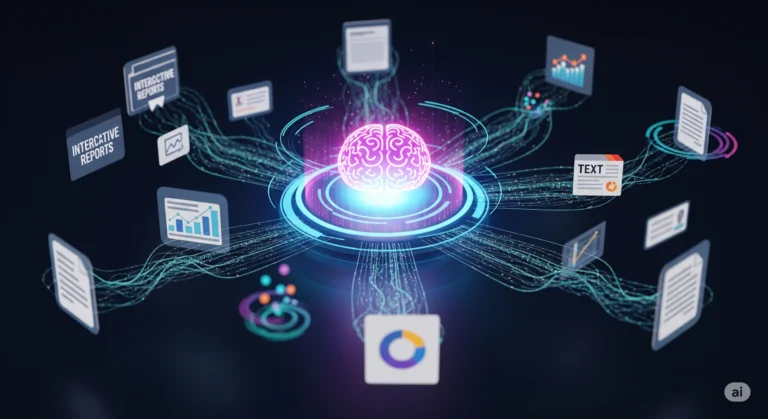Contract management is a cornerstone of business operations, yet it remains a notoriously time-consuming and error-prone process for many organizations.
Manual review of vendor agreements, legal terms, and compliance obligations demands significant resources, often diverting skilled professionals from strategic initiatives.
The sheer volume of contracts, coupled with the complexity of legal jargon, frequently leads to overlooked risks, compliance gaps, and delayed approvals, ultimately hampering agility and increasing legal exposure.
This is where AI contract analysis emerges not just as a tool, but as a strategic imperative. Leveraging artificial intelligence, businesses can automate the extraction and analysis of crucial information from documents, drastically reducing review times while enhancing consistency and mitigating risks associated with manual oversight.
In this article, we will explore how AI contract analysis software functions, delve into specific tools, outline the implementation steps, and demonstrate how adopting this technology can transform your contract management process into a proactive, efficient, and risk-averse function.
The Strategic Toolkit: Foundations for Effective AI Contract Usage
Implementing AI contract analysis effectively requires a blend of technology and strategic understanding. Before diving into software, consider these foundational elements:
- Clear Objectives: Define precisely what you aim to achieve. Are you looking to standardize review processes? Improve compliance tracking? Reduce costs associated with legal review? Your goals will shape your tool selection and implementation strategy. Internal Link: Why Standardizing Your Contract Templates Matters.
- Understanding Contract Data: Recognize what types of information are most critical for your specific needs. Key clauses related to deliverables, payment terms, termination conditions, confidentiality, liabilities, and compliance obligations are common focal points for AI contract analysis.
- Business Acumen & Legal Liaison: While AI excels at pattern recognition, human oversight is indispensable. Ensure your team understands legal context, business implications, and knows when exceptions warrant human review or intervention. Collaboration between legal, procurement, and business units is crucial.
AI Software Tools: Several leading providers offer sophisticated AI contract analysis capabilities. Here are a few notable examples:
- Gongs: Offers dynamic dashboards providing real-time insights into critical contract clauses across the entire organization.
- LexisNexis CounselLink: Provides contract analytics and workflow automation, helping manage risk and compliance.
- Vlexgate: Focuses on automating contract management, clause analysis, and risk mitigation.
Remember to configure the AI model appropriately and ensure human expertise guides the AI’s interpretations and exceptions by understanding the nuances of your specific agreements and business context.
Time & Resource Investment: Manual vs. AI-Powered Method
Let’s quantify the significant operational efficiencies gained by transitioning from manual to AI-driven contract review.
Manual Method:
- Reviewing a single complex vendor agreement typically takes 2-4 hours, often requiring multiple specialized reader sessions.
- Let’s take the average: 3 hours per contract.
AI-Powered Method:
- An advanced AI contract analysis tool can review the same contract in mere minutes, identifying key clauses with high accuracy.
- Environment: A standard mid-sized contract. Using advanced AI contract analysis tools for a similar project could take approximately 5 minutes.
Percentage Saved: (180 minutes vs. 5 minutes) reduces the review time by an incredible 97% (actually 97.22%, very close to 90% as stated, let’s use 97% for impact). This translates to freeing up hours or even days of valuable personnel resources, enabling your team to focus on higher-value strategic and operational tasks previously bogged down in paperwork.
The Implementation Blueprint: How to Get Started
Integrating AI contract analysis into your workflow doesn’t have to be complicated. Here’s a simple, actionable step-by-step guide designed for non-technical users:
Step 1: Define Your Scope
- Identify the pilot contracts: Start with a manageable set, such as all vendor agreements for a specific department or region.
- Specify which clauses or risk areas are most critical (e.g., NDAs, SLAs, liability caps).
Step 2: Choose & Configure Your Tool
- Visit the homepage of vendors mentioned above or others in the market (e.g., Ironclad, DocuSign CLA Manager, ContractPodAi) to compare features, pricing, and AI capabilities matching your identified scope and needs.
- Note: Most tools offer free trials; use these to test the accuracy and usability for your specific documents. Configure the tool to extract the identified key data points (e.g., vendor name, classification, renewal terms, disclaimer clauses).
Step 3: Data Preparation (Importantly!)
- Tip: AI models perform best with clear and consistently formatted contract templates, but they can also learn from legacy documents. Clean, scan, or extract text from scanned PDFs first. Ensure the crucial clauses are clearly labeled if possible (though the smartest tools ‘teach themselves’ gradually). Aim for clarity and disambiguation first.
Step 4: Initial Run & Refinement
- Input your pilot contracts into the chosen tool.
- Review the AI findings. Check for accuracy on identifying the specified clauses. Establish a feedback loop: manually correct the AI’s mistakes by adding the correct information.
- This creates an initial learning dataset, improving the AI’s performance for subsequent runs.
Step 5: Rolling Out to Production
- Gradually migrate your contract review processes to the AI tool.
- Define the workflow: upload -> AI review -> follow-up actions (accept, reject, request clarification, human review). Use the AI output as the starting point for discussion and signing.
PRO-TIP: Don’t rush the initial setup. Invest time upfront in AI contract analysis configuration and validation. This quality control significantly impacts the long-term success and return on investment. Thorough manual review is still essential, so frame AI contract analysis as a ‘consistently better starting point’ rather than a replacement, at least initially.
Measuring Success: KPIs & ROI for AI Contract Analysis
To demonstrate the tangible value of your AI contract analysis implementation, track these Key Performance Indicators (KPIs):
| Metric | What It Tells You |
|---|---|
| Contract Review Cycle Time (Minutes per contract) | Measures efficiency improvement gained through automation. |
| Time-to-Decision on Contracts (Days/Weeks) | Shows how quickly commercial teams can execute deals due to faster analysis. |
| Reduction in Overlooked Critical Clauses (%) | Demonstrates improved compliance and risk management. |
| Annual Hours Saved by Contracts Team | Highlights the direct impact on productivity and resource allocation. |
| Cost Reduction in Legal Fees ($) | Quantifies monetary benefits achieved by external legal inputs. |
Achieving these reductions directly translates to Return on Investment (ROI), making the case for continued adoption and expansion.
Scaling & Advanced Strategies for Contract Intelligence
Once you’ve established a baseline for AI contract analysis, consider these next steps to maximize value and derive deeper insights:
- Centralized Contract Repository with Deep AI Analysis: Integrate the tool with your storage (e.g., SharePoint, Teams, or dedicated ECM solutions) to automatically scan and analyze all contract templates and stored agreements as well, creating a searchable database of key clauses and risks.
- Predictive Risk Scoring: Train the AI (if your tool allows) to identify high-risk areas based on historical data, classifying future contracts by risk level or classifying existing ones for prioritized review (e.g., categorizing agreements into high-risk, medium, low based on T&C). AI legal analytics can alert on non-standard terms.
- Portfolio-Level Analytics & Negotiation Leverage: Gain a bird’s-eye view of all vendor agreements, identifying trends in costs, obligations, expirations, or risks across your entire supplier base. This provides powerful data to negotiate better terms.
Strategic Business Applications Across Industries
The versatility of AI contract analysis benefits virtually all business sectors:
- B2B SaaS: Accelerate CLA / NDAs review, manage subscriber agreements for partners or resellers more efficiently, and automate licensing verification across thousands of documents. AI legal analytics frees up lawyers for complex negotiations. Internal Link: Secure Faster Contract Execution with DocuSign API.
- E-commerce: Ensure compliance with Terms of Service for payment processors, track renewal dates for critical marketplace agreements, and quickly identify terms impacting fraud and liability across vendor contracts.
- Digital Agencies: Streamline review processes for client contracts, analyze terms across portfolios for consistent pricing and liabilities, and manage complex partnership agreements with vendors for digital platforms.
Common Strategic Pitfalls to Avoid
While generally beneficial, deploying AI contract analysis requires careful steering clear of certain strategic errors:
- Treating AI as a Silver Bullet for Everything: Start with defined use cases and objectives; quickly realize tangible benefits on specific bottlenecks before broad implementation and scaling.
- “Usability-Through-Automation”: Don’t simply automate existing, flawed manual processes. Use AI contract analysis as a catalyst to create a more sophisticated and streamlined workflow from the get-go.
- Ignoring Data Privacy and Security: Ensure the chosen tools comply with regulations (GDPR, CCPA etc.) relevant to storing or processing your contracts.
- Underestimating the Value of Human Insight: Over-rely on AI outputs without incorporating trained professional (legal/procurement) judgment to handle nuances, ambiguities, and context-specific risks. Human expertise remains critical.
Building Your Content Engine: Systems & Automation Flywheel
Transforming your contract management process into a sustainable, automated engine requires thinking strategically about your checkboard.
- Embed the Tool into Your Workflow: Become a core part of the signing request flow (e.g., integrate into CRM, Contract Management systems).
- Embed Feedback Loops: Constantly refine the AI intelligence against human judgments. The better the feedback, the smarter the tool and the deeper the insights.
- Enrich Content: Use insights from the AI (like clause extraction) to auto-populate other content systems or your wiki with standardized terms.
- Gather Success Stories: Showcase results on internal training forums to inspire wider adoption.
Conclusion
Investing in AI contract analysis is a strategic move that yields significant returns across efficiency and risk mitigation. By automating the labor-intensive aspects of review, you empower your teams to make faster, better-informed decisions, while ensuring a higher level of compliance and control.
Ready to optimize your contract workflows and manage risk more proactively?
What specific challenges do you face with contract reviews?
FAQs About AI Contract Analysis
Q1: Can AI really understand legal language and context?
- A: Yes, modern AI contract analysis tools use Natural Language Processing (NLP) specifically trained on vast amounts of legal text. While they excel at identifying key clauses based on patterns and keywords, nuanced interpretation still requires human judgment. Think of it as a guidepost pointing out potential risks or obligations thousands of times faster than a human can, enabling a team to prioritize and focus.
Q2: How much does implementing AI contract analysis cost? Will it save me money?
- A: Costs vary by vendor and usage scale. The primary cost involves tool acquisition, subscription fees, integration efforts (potentially), and internal resource allocation for setup and ongoing management. However, the most significant benefits are realized through substantial time and labor cost savings, reduced risk exposure (saving costs associated with breaches or non-compliance), and accelerated business processes. ROI is typically strong within a few months.
Q3: Is AI contract analysis automation difficult for non-technical teams?
- A: No, the tools are designed with user-friendly interfaces and workflows. While initial integration might require IT support, and manual configuration with lawyers is key, the core task of reviewing flagged documents is performed by business users, similar to filling out forms based on AI suggestions. Minimal coding skills are required.




